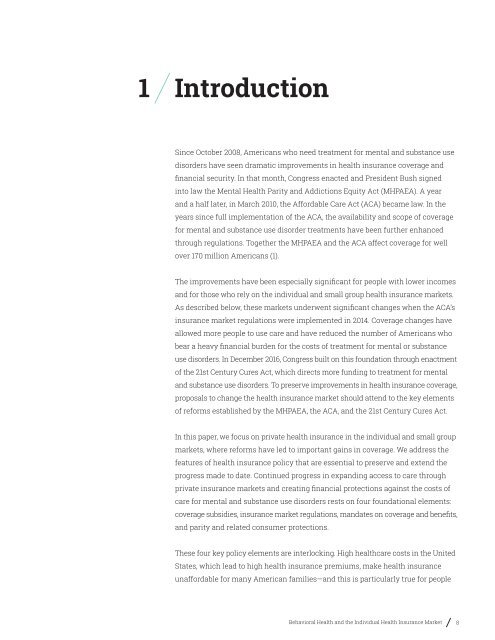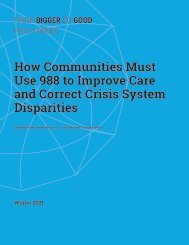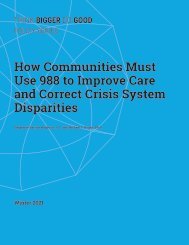Behavioral Health and the Individual Health Insurance Market
You also want an ePaper? Increase the reach of your titles
YUMPU automatically turns print PDFs into web optimized ePapers that Google loves.
1<br />
Introduction<br />
Since October 2008, Americans who need treatment for mental <strong>and</strong> substance use<br />
disorders have seen dramatic improvements in health insurance coverage <strong>and</strong><br />
financial security. In that month, Congress enacted <strong>and</strong> President Bush signed<br />
into law <strong>the</strong> Mental <strong>Health</strong> Parity <strong>and</strong> Addictions Equity Act (MHPAEA). A year<br />
<strong>and</strong> a half later, in March 2010, <strong>the</strong> Affordable Care Act (ACA) became law. In <strong>the</strong><br />
years since full implementation of <strong>the</strong> ACA, <strong>the</strong> availability <strong>and</strong> scope of coverage<br />
for mental <strong>and</strong> substance use disorder treatments have been fur<strong>the</strong>r enhanced<br />
through regulations. Toge<strong>the</strong>r <strong>the</strong> MHPAEA <strong>and</strong> <strong>the</strong> ACA affect coverage for well<br />
over 170 million Americans (1).<br />
The improvements have been especially significant for people with lower incomes<br />
<strong>and</strong> for those who rely on <strong>the</strong> individual <strong>and</strong> small group health insurance markets.<br />
As described below, <strong>the</strong>se markets underwent significant changes when <strong>the</strong> ACA’s<br />
insurance market regulations were implemented in 2014. Coverage changes have<br />
allowed more people to use care <strong>and</strong> have reduced <strong>the</strong> number of Americans who<br />
bear a heavy financial burden for <strong>the</strong> costs of treatment for mental or substance<br />
use disorders. In December 2016, Congress built on this foundation through enactment<br />
of <strong>the</strong> 21st Century Cures Act, which directs more funding to treatment for mental<br />
<strong>and</strong> substance use disorders. To preserve improvements in health insurance coverage,<br />
proposals to change <strong>the</strong> health insurance market should attend to <strong>the</strong> key elements<br />
of reforms established by <strong>the</strong> MHPAEA, <strong>the</strong> ACA, <strong>and</strong> <strong>the</strong> 21st Century Cures Act.<br />
In this paper, we focus on private health insurance in <strong>the</strong> individual <strong>and</strong> small group<br />
markets, where reforms have led to important gains in coverage. We address <strong>the</strong><br />
features of health insurance policy that are essential to preserve <strong>and</strong> extend <strong>the</strong><br />
progress made to date. Continued progress in exp<strong>and</strong>ing access to care through<br />
private insurance markets <strong>and</strong> creating financial protections against <strong>the</strong> costs of<br />
care for mental <strong>and</strong> substance use disorders rests on four foundational elements:<br />
coverage subsidies, insurance market regulations, m<strong>and</strong>ates on coverage <strong>and</strong> benefits,<br />
<strong>and</strong> parity <strong>and</strong> related consumer protections.<br />
These four key policy elements are interlocking. High healthcare costs in <strong>the</strong> United<br />
States, which lead to high health insurance premiums, make health insurance<br />
unaffordable for many American families—<strong>and</strong> this is particularly true for people<br />
<strong>Behavioral</strong> <strong>Health</strong> <strong>and</strong> <strong>the</strong> <strong>Individual</strong> <strong>Health</strong> <strong>Insurance</strong> <strong>Market</strong> 8

















